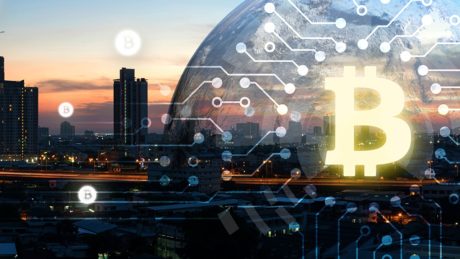In an article recently published in Juriste Magazine, Partner Marc Jones takes stock of how English law is dealing with cryptoassets, what we’ve learned so far and what problems remain.
Bitcoin was born in January 2009. To say it arrived largely unnoticed by most of the world would be an understatement. Just over a decade on, and even those who still do not have the faintest idea what a cryptocurrency actually is or how ”blockchain” operates, will at least have heard of them. For those who did stop and look around, the reality is that over the last decade cryptocurrencies and the blockchain technologies that underpin them have moved at an ever-accelerating speed from their origins on the periphery of the periphery and into the financial mainstream. Early prophecies that cryptocurrencies and blockchain technology generally were everything from a criminal enterprise to simply pointless have fallen away. Financial markets now offer a variety of products linked to cryptocurrencies, from plain vanilla futures to exchange traded notes. In July 2019 the Securities and Exchange Commission approved a digital public token offering to the general public for the first time. At the retail end there is an ever-growing array of applications enabling consumers to transact and invest in a variety of cryptocurrencies, commonly grouped under the tag “DeFin”: decentralised finance.
As the technology has raced ahead, a wide range of novel and difficult questions have arisen about the legal fundamentals of this new asset class and its underlying technology. Until very recently most legal activity has been focussed on controlling this new asset class through criminal or financial regulatory measures. Perhaps that is a product of the history of cryptocurrencies which early on were portrayed as an off-grid method of selling and purchasing illegal goods and laundering money. That regulatory focus has tended to obscure the legal fundamentals, in particular “what are cryptocurrencies”: mere information, intangible property, or something else entirely? The implications are enormous, and answers are required urgently to provide the legal certainty needed by developers, financial service providers and investors in this rapidly growing new technology.
The most significant English response to date came on 18 November 2019 when Sir Geoffrey Vos, Chancellor of the High Court, launched the Legal Statement on Cryptoassets and Smart Contracts (the “Legal Statement”) and in doing so made the point that “There is no point in introducing regulations until you properly understand the legal status of the asset class that you are regulating”. By coincidence the launch was book-ended by the first two interim judicial decisions (Robertson v Persons Unknown in July 2019 and AA v Persons Unknown in December 2019) in which bitcoin was treated as legal property. It is fair to say that the Legal Statement is a first in English law and a genuine legal landmark; and that the two cases are important indicators of the challenges ahead.
Robertson v Persons Unknown
Mr Robertson was the victim of a “spear phishing” attack which resulted in one of Mr Robertson’s intended investment, of 100 bitcoin (at the time worth approximately £1.2M) being misdirected to the fraudster(s). These were the “persons unknown” who were sued as the first defendant. Having established that 80 bitcoin had been sent to a wallet held at Coinbase UK Ltd, the UK arm of San Francisco-based Coinbase, one of the world’s leading cryptocurrency exchanges. Mr Robertson applied to court for a proprietary interim injunction called an asset preservation order to “freeze” the 80 bitcoin , as well as a Bankers Trust order to permit Coinbase to reveal the identity of the individual who controlled the wallet containing the 80 bitcoin. (A Bankers Trust order is an order that typically requires a bank to provide details ordinarily protected by the bank’s duties of confidentiality.) Coinbase was supportive of Mr Robertson’s claim but was limited in what it could do, given its contractual and regulatory obligations, unless complying with a court order. A key issue at the hearing was: is bitcoin “personal property”? If not, then a proprietary injunction could not be made. The prevailing view was that in English law: “All personal things are either in possession or in action” (Lord Justice Fry in Colonial Bank v Whinney (1885)). The first is a “thing” that you can take physical possession of, and the second is a property right that can only be obtained or enforced through legal action. At first blush, bitcoin is neither. It is not a physical thing and English law is clear that intangibles are not chose in possession (OBG v Allen).
And unlike, for example, money in a bank account which creates a relationship of debtor and creditor, a bitcoin is an intangible “thing” that does not depend upon a legal right enforceable against some other person in order to have value. In that sense, bitcoin it is more like a bank note than the money in your bank account: the former has value simply by virtue of being a bank note to which people attach value; the latter depends upon the account-holder’s ability to enforce a right against the bank and the bank’s ability to pay. When the Robertson application was heard there was no English authority on the issue (The decision in Vorotyntseva had not been made public at the time), so the claimant relied on B2C2 Ltd v Quoine Pte Ltd [2019] SGHC(I) 03 in which the Singapore International Commercial Court held that bitcoin are personal property. The closest English law analogue was Armstrong DLW GmbH v Winnington Networks Ltd [2012] EWHC 10(Ch), which concerned the fraudulent transfer of carbon emissions allowances (EUAs). In that case the court held that the claimant had a proprietary restitutionary claim for the value of the EUAs which constituted “a chose in action or some form of other intangible property”.
Despite the fact that cryptocurrencies have no physical existence, the idea that cryptocurrencies may be things in possession was not regarded as unthinkable. For example, the Financial Markets Law Committee (FMLC) (July 2016) took the view that “it may be convenient to understand [cryptocurrencies]… as a kind of hybrid: ‘virtual chose in possession’. That is, intangible property with the essential characteristics of chose in possession.” In the event the judge in Robertson was prepared to proceed on the basis that whether bitcoin is a thing in possession, in action or some form of other intangible property, – here was a serious issue to be tried and that it was appropriate to make an interim proprietary injunction to protect Mr Robertson’s interest.
Why does it matter whether cryptocurrencies are property? In the narrow context of fraud claims, obtaining proprietary relief gives the claimant a much stronger position. The specific assets are better secured and (generally) cannot be used to pay the defendants costs. Then claimants’ ability to trace and the range of remedies available is increased. Also the cryptocurrency might appreciate significantly in value during the time the claimant is out of possession and the claimant may want the specific cryptocurrency returned rather than having to seek damages and engage in arguments over the quantum of loss.
Whether cryptocurrencies are chose in action, in possession or something else does matter. Defences under English law that are open to a defendant who has received stolen cryptocurrency are probably wider if the cryptocurrency is treated as a chose in possession than a chose in action. The starting point for both is the ‘nemo dat’ rule (i.e. a seller of property cannot give better title to the property than he himself has). The main exception to that rule is the ‘bona fide purchaser for value without notice’ rule (i.e. a person who buys property in good faith and is not on notice of defects in the transferor’s title takes good title). While that applies to both types of personal property, it is more difficult to see how it could affect a chose in action (and authorities on this are hard to find). Also, there are far more statutory defences available in respect of chose in possession (for example sale of goods legislation). In short, the ability to satisfy the court that there is a serious issue could well be harder to satisfy if cryptocurrencies are classified as chose in possession because there will be a much greater likelihood of the defendant(s) having a potentially good defence. And quite what the position is if they are some third type of property is unknown.
Beyond the context of fraud litigation, whether cryptocurrencies are property will be a matter a importance in a variety of commercial contexts (for example taxation, sale of goods legislation, transfer of title, the taking of security, etc.) and perhaps especially in insolvency scenarios. For example, an office-holder would need to know against whom action could be taken in order to realise the value of the virtual currency.
The Legal Statement on Crypto-assets and Smart Contracts
The Legal Statement is the result of the Law Tech Delivery Panel’s (“LTDP”) consultation in relation to cryptoassets, distributed ledger technology and smart contracts. The LTDP was established by the UK Government, the Judiciary and the Law Society of England and Wales and has as its overarching objective the promotion of the use of technology in the UK’s legal sector. The UK Jurisdiction Taskforce (UKJT) is one of six taskforces established by the LTDP for the purposes of achieving this objective, and it is the UKJT that produced the Legal Statement. The stated objective of the UKJT is “to demonstrate that English law and the jurisdiction of England and Wales together provide a state-of-the-art foundation for the development and use of DLT, smart contracts and associated technologies”.
The Legal Statement was launched at a packed Guildhall in London on 18 November 2019 by Sir Geoffrey Vos, Chancellor of the High Court:
“I believe that this morning is a watershed for English law and the UK’s jurisdictions. Our statement on the legal status of cryptoassets and smart contracts is something that no other jurisdiction has attempted. It is genuinely groundbreaking… The first thing to understand about cryptoassets is that they are not all about Bitcoin and Bitcoin mining as some people tend to think when the subject is raised. There is an endless spectrum of types of cryptoasset and cryptocurrencies, many of which already are or certainly will be designed for use as wholesale and retail payment mechanisms. They will be what one might call investment grade. It is for that reason that the thinking behind this legal statement was that what was lacking was a clear view of the legal status of cryptoassets under English law. If the legal foundation could once be established, uncertainty would dissipate, and it would be possible for the regulators to consider what regulatory measures were needed, and for the courts to consider, where appropriate, what remedies might be available in respect of transactions involving the transfer and securitisation of cryptoassets… I hope that the document will be hugely influential on legal thinking across the common law world”.
In the foreword to the Legal Statement Sir Geoffrrey notes: “I hope that the Legal Statement will go a long way towards providing much needed market confidence, legal certainty and predictability in areas that are of great importance to the technological and legal communities and to the global financial services industry.”
The Legal Statement has an explicitly commercial purpose. It anticipates the day when “investment grade” cryptoassets will be commonplace. In a wide-range of international commercial activities English law is the most widely chosen governing law in the word, and it is nothing if not rooted in, and accommodating of, the changing realities of commercial enterprise. So it is not surprising that English law should want to get ahead of the game. But it is the manner in which this has been attempted that is genuinely novel. The Legal Statement is not a piece of legislation nor a binding judicial decision. As Sir Geoffrey explained: “The process that the taskforce adopted was to draft a short list of legal questions, and then to consult widely about the appropriateness of those questions amongst the tech community, the financial services sector, the regulators and the lawyers. The Taskforce held public meetings and received a wide range of the very best expert opinion. The resulting questions were put to the team of expert QCs and barristers asking them to deliver a definitive statement of what English law now provides in this area. The outcome is not about what they would like English law to be; it is about what they believe English law actually to be”. As such it has no legally binding effect – or any legal effect at all.
Having said that, the range and quality of individuals involved in the consultation should inevitably mean that significant weight will be attached to the Legal Statements conclusions. What are they?
The key conclusion of the Legal Statement as regards cryptocurrencies (It must be remembered that the report also looked at the legal status of “smart contracts” which are not considered in this article) is that:
- cryptoassets have all of the indicia of property;
- the novel or distinctive features possessed by some cryptoassets – intangibility, cryptographic authentication, use of a distributed transaction ledger, decentralisation, rule by consensus – do not disqualify them from being property;
- nor are cryptoassets disqualified from being property as pure information, or because they might not be classifiable either as things in possession or as things in action;
- cryptoassets are therefore to be treated in principle as property.
Significantly the Legal Statement also concludes that the famous statement of Lord Justice Fry in Colonial Bank v Whinney (referred to above), properly understood, did not restrict the types of personal property known to English law in the way it had been assumed for the best part of 150 years, but that “the class of things in action could be extended to all intangible property (i.e. it was a residual class of all things not in possession) rather than on the basis that the class of intangible property should be restricted to rights that could be claimed or enforced by action”.
There is an important qualification to all this. Whether or not any particular cryptoasset is treated as property will depend on its specific traits. The number and variety of cryptoassets is ever-expanding, and the underlying structure of each can differ radically. What traits must a particular cryptoasset possess in order to qualify as property? The authoritative description of the necessary characteristics of property is set out in National Provincial Bank v Ainsworth (1965): before a right or an interest can be admitted into the category of property it must be: (a) definable; (b) identifiable by third parties; (c) capable in its nature of assumption by third parties, and (d) have some degree of permanence or stability. In other words: certainty, exclusivity, control and assignability.
One of the great virtues of the Legal Statement is the brevity and accuracy with which it cuts through difficult issues to produce clear answers. It deals with many other issues which flow from the conclusions on cryptocurrencies as property, such as transfer, security and insolvency. But the Legal Statement is very far from comprehensive, and never set out to be. Two areas are with noting. First, how rules of private international law are to be applied to the proprietary aspects of dealings in cryptoassets. This is a particularly complex area and this is reflected in the Legal Statement: “…we think that there is a good argument that the normal rules should not apply… [but] it is very difficult to say which rules would be used instead”. Second, the Legal Statement specifically did not address the issue of remedies. Again, another fundamental and difficult area. Quite how problematic these issues will prove to be is touched on in the case of AA v Person Unknown
AA v Persons Unknown
The decision in AA v Person Unknown is believed to be the first occasion on which any common law court has not only referred to the Legal Statement but has positively approved its conclusions as regards cryptocurrencies. Beyond that AA is a fascinating early example of the many difficult questions that disputes involving cryptocurrencies, indeed any blockchain based digital asset, are going to raise.
The claimant was the English cybercrime insurer of a Canadian company targeted by the BitPaymer ransomware virus. The virus encrypted the company’s files and demanded a US$950,000 payable in bitcoin as ransom to decrypt them. The claimant paid the ransom for its insured by buying 109.25 bitcoins and transferring them to a bitcoin address provided by the anonymous attackers (the “persons unknown”). Once the files had been recovered, the claimant traced and attempted to recover the bitcoin. 96 bitcoin were located at an address linked to the cryptocurrency exchange known as Bitfinex, which is operated by two BVI companies.
The judge granted an interim proprietary injunction over the bitcoin against the BVI companies and the attackers. The judge stated: “I consider it is fallacious to proceed on the basis that the English law of property recognises no forms of property other than choses in possession and chose in action. The reasons for this are set out at paragraphs 71 to 84 of the Legal Statement”.
Cases combining “persons unknown” and cryptocurrencies present novel legal problems for unwary claimants, and it’s clear that difficulties arose in AA. As the Bitfinex companies were based in the BVI, and the whereabouts of the “persons unknown” was not known, the claimant needed the court’s permission to serve process out of the jurisdiction. Although the claimant insurer was based in England and was subrogated to the rights of the assured, the malware attack had been carried out against a Canadian company, and presumably the tortious acts and/or damage encompassed by the hack occurred in Canada, providing no basis for English jurisdiction.
What claims could the claimant pursue in England? The judge explored in some depth the potential causes of action and jurisdictional bases, which were clearly very problematic for the claimant. Ultimately, the claimant narrowed its application to “the claims of the insurer in restitution and/or constructive trust against all four defendants”, seeking a proprietary injunction against all defendants. Essentially the claim was that: (a) the $950,000 used to purchase bitcoin was the claimant’s property; (b) the payment was wrongfully extorted by the “persons unknown” who have no right to the money, and (c) the bitcoin represent the traceable proceeds of the claimant’s money against which it has a claim in unjust enrichment.
The judge concluded that the claims for restitution and constructive trust gave the English court jurisdiction on two bases: the claimant was seeking an interim remedy under s.25.1 of the Civil Jurisdiction and Judgments Act 1982; and the claim was in tort where loss was (likely to be) sustained within the jurisdiction or result from acts (likely to be) committed in the jurisdiction. Both are problematic but only the second is on interest for present purposes. (The court’s jurisdiction to grant interim remedies under s.25 is limited to doing so in support of foreign proceedings. Here, no mention is made of any foreign proceedings in respect of which a s.25 order was sought.)
The judge proceeded on the basis that because the claimant is based in England and had paid the $950,000 from an English bank account, damage was suffered in the jurisdiction. It’s not clear whether it was the location of the claimant or the bank account or both that mattered. But that is not the full picture. The claimant paid the money to its agent, JJ, who then purchased the bitcoin which were then transferred to the “persons unknown”.
On that basis, the claimant didn’t suffer loss until JJ transferred the bitcoin. As such, the focus should be on the bitcoin. But where was the bitcoin transferred from? Arguably nowhere. As a bitcoin is simply a record on a distributed ledger that has no locus, it does not exist anywhere. On another view, it is wherever the payor is when the transfer is made. But should that be the claimant’s location (England) or its agent’s (which may have been elsewhere?) These are difficult questions with which the English courts are going to have to grapple.
Finally, it is worth highlighting a few difficult points which are not addressed in AA v Person Unknown but are bound to arise in cryptocurrency fraud claims in the future. The applicable law of a tort under article 4 of Rome II is “the law of the country in which the damage occurs irrespective of the country in which the event giving rise to the damage occurred and irrespective of the country or countries in which the indirect consequences of that event occur”. If it is correct that AA’s loss was suffered in England because the ransom money was paid out of an English bank account, then English law applies. But what if it is the place of the transferor or the transfer of the bitcoin (if there is such a thing) that is determinative? Even in cases where the High Court has jurisdiction on some basis unrelated to the place where damage was suffered, the applicable law must be considered because it affects what claims and (interim) remedies can be pursued. Suppose AA’s agent had been outside England when he transferred the bitcoin, say Utopia; and (to keep it simple) that he transferred the bitcoin from the wallet of a cryptoexchange also located in Utopia. The law of Utopia would prima facie apply to any tort claims. If Utopian law permits claims for restitution and/or constructive trust, would the Utopian law also apply to any tracing exercise, or would English law still apply? And what if the law of Utopia does not treat bitcoin as property at all? What type of interim and final relief could the claimant seek from an English court?
What have we learned so far?
It now looks increasingly clear that English law will treat bitcoin and similar cryptoassets as legal property. The first outing of the Legal Statement in court has been a positive one, its approach and conclusions endorsed. That is a good start and good news for all commercial parties involved in this area. But an authoritative and binding decision on this specific point is still needed and we may have to wait a while for the right case to reach appeal level for that to happen.
However, that positive news is tempered by the fact that AA highlights how many more legal conundrums lie in wait in this area which have yet to receive the detailed judicial consideration that will be needed in order to provide clarity. As cryptocurrencies, digital assets more broadly, and the underlying technologies on which they rest become ever more widely adopted and continue to multiply in number, the days when any lawyer could dismiss this area as one that has no relevance to his/her practice are rapidly diminishing. Banking and financial markets, corporate finance, international trade, insolvency, estate management, trusts, tax, divorce, intellectual property, the list goes on. And if you thought that the pace of development over the last decade has been surprising, then you need to “stop and look around once in a while” over the next decade – or you’re probably in for a shock.
Marc Jones represented Mr Robertson in the Robertson v Persons Unknown litigation.
Article first published in UIA magazine Juriste International 2020-2. The magazine can be accessed here.
You can find further information regarding our expertise, experience and team on our Fraud, Cybersecurity and Incident Response and Commercial Litigation pages.
If you require assistance from our team, please contact us or alternatively request a call back from one of our lawyers by submitting this form.
Subscribe – In order to receive our news straight to your inbox, subscribe here. Our newsletters are sent no more than once a month.






